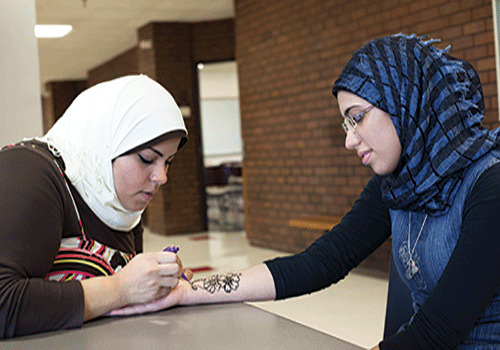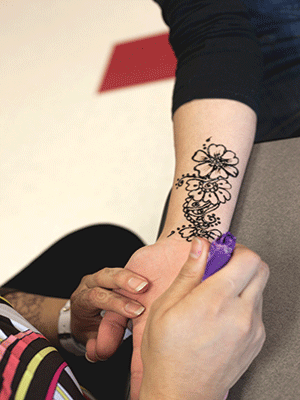
By Chris Cunningham
The Scene staff
Sarah Muhsen is an artist, but she draws on people instead of canvas.
She decorates the hands and arms of Forest Park students and faculty with henna tattoos, continuing an art form that has been around for thousands of years in the Middle East, India and Africa.
“American people like it because it is temporary, only two weeks,” she said.
Muhsen, 20, is a general studies student who moved to the United States from Iraq in 2008. She started drawing cartoons and portraits with pencil in high school then expanded to tattoos a year ago.
Muhsen was doing it for friends at no charge then found that others were willing to pay $10 for tattoos that go from the elbow to fingers and $5 for tattoos from the wrist to fingers.
“People started to notice it on my hands and asked if I could do that for them,” she said.
Henna tattoos typically consist of abstract shapes and flowers, but Muhsen has been taking American requests for specific images, including a birdhouse between someone’s shoulder blades.
At first, it took Muhsen 30 minutes to go from someone’s elbow to fingers, but now she can do the job in 10 minutes.
It’s not apparent the tattoos are temporary by sight.

“Some people think it is (a permanent) tattoo,” Muhsen said. “Not all people know what henna is.”
Respiratory therapy student Norma Williams asked for a henna tattoo after seeing one on Muhsen’s arm before Eid al-Fitr, a Muslim holiday for which many people get tattoos.
“She did flowers and a paisley print, some dots, squiggles and vines,” said Williams, 32.
Williams received many complements on the tattoo.
“Everybody loved it and thought it was beautiful and amazing,” she said. “They asked what it meant and what certain designs signified. There are certain meanings for things, but the flowers are just aesthetic.”
Williams’ sister liked the tattoo so much, the two went to Muhsen’s house so she could get one like it.
“It was a beautiful experience,” Williams said. “She told us how she had a henna tree at her house in Iraq. She served us cookies and tea and even taught us how to say, ‘I love you’ in Arabic. It was really nice.”
Henna trees grow leaves that provide the dye for tattoos. It’s available in powder form at most international grocery stores. All people need to do is add water to make a paste.
Sharon Person, a professor of English as a second language, also had Muhsen draw a henna tattoo on her arm after one of her colleagues got one.
“I’m so impressed with how she does it free hand,” Person said. “She has shown me pictures of what she has done for her mother and her sister. It is just beautiful. I am very impressed with her.”
Person is an American married to Iranian man. She lived in Iran, where henna tattoos are popular, for a year and half in the 1980s.
“I hadn’t seen (tattoos) in the United States much, and when I saw what (Muhsen) had done for somebody else, I was excited to have her to do for me as well,” she said.
Muhsen plans to transfer to St. Louis University after graduating from Forest Park next year. She considered majoring in design, engineering and surgical technology, but settled on radiation therapy.
Muhsen takes appointments for henna tattoos. She can be reached at 314-359-9876.
